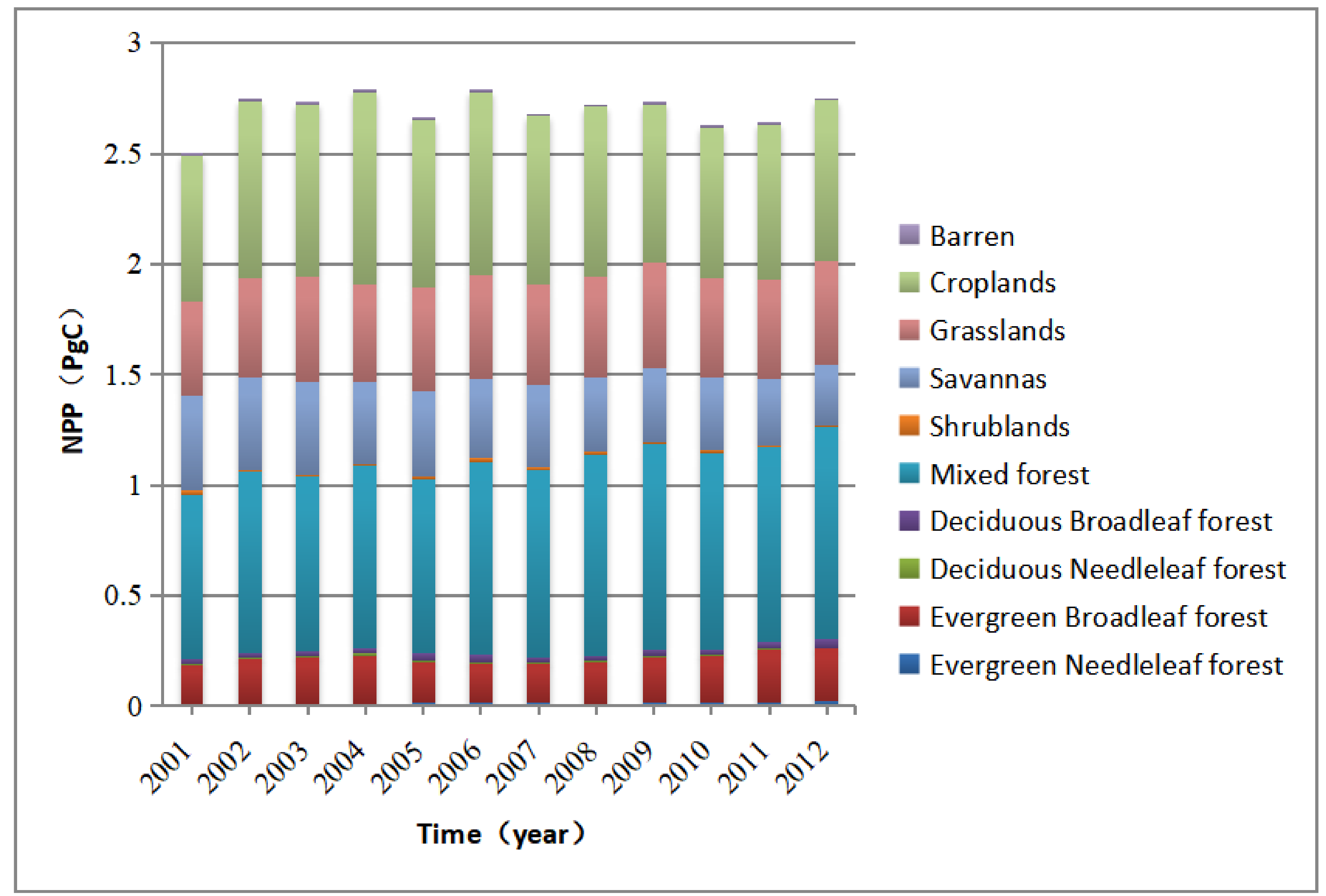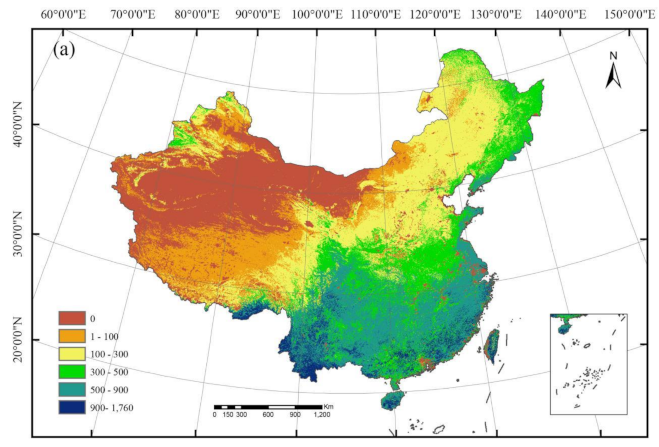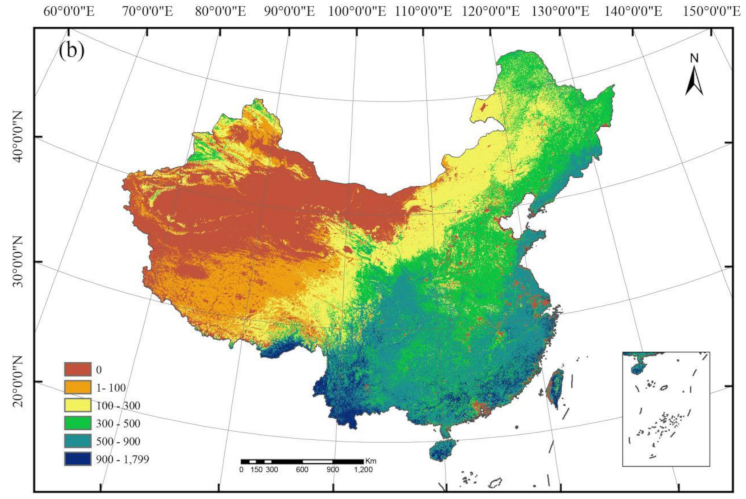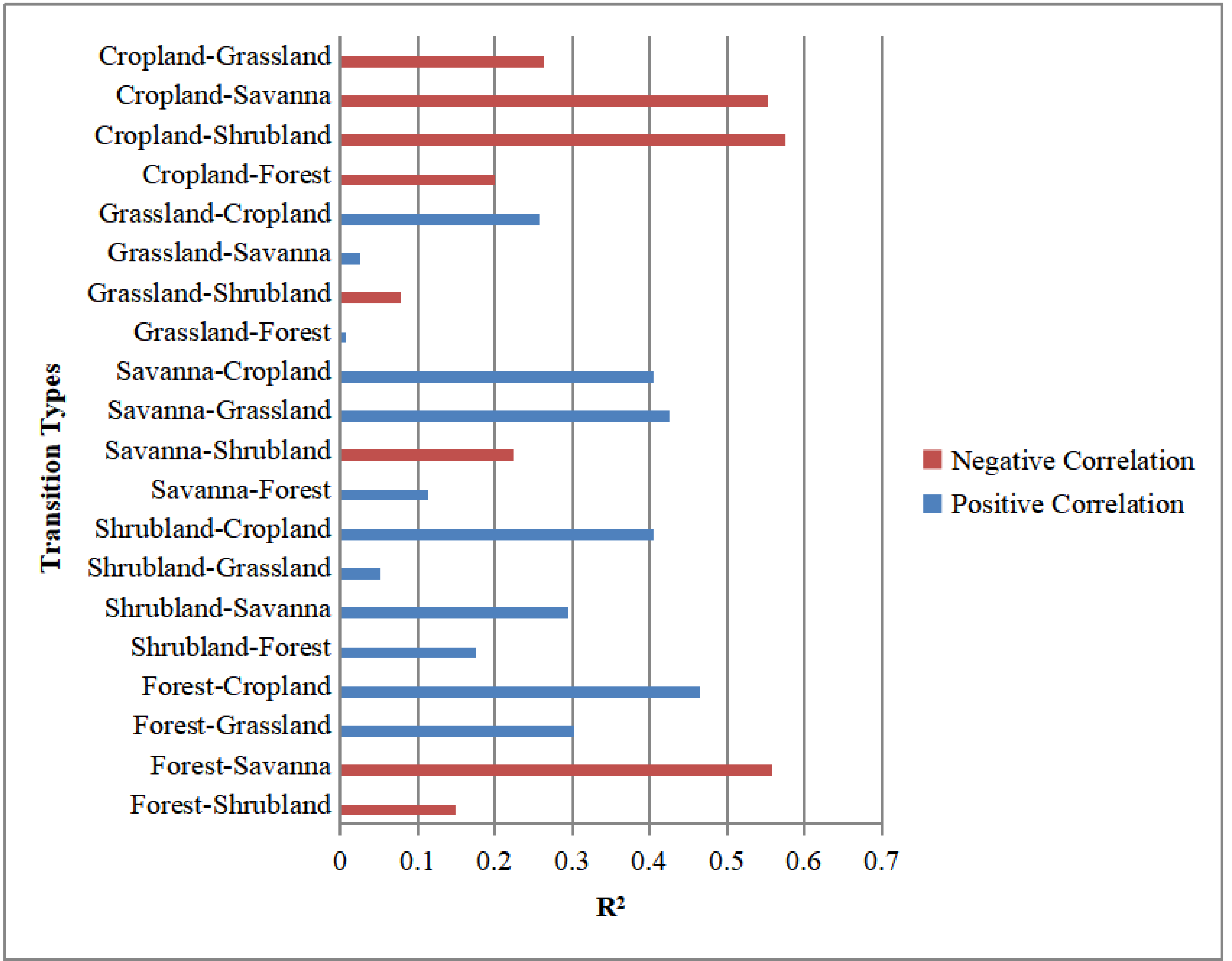Effects of Land Cover Changes on Net Primary Productivity in the Terrestrial Ecosystems of China from 2001 to 2012
Abstract
:1. Introduction
2. Materials and Methods
2.1. Data Sources
2.2. Data Analysis
3. Results
3.1. Land Cover Changes in China from 2001–2012
3.2. Annual Changes in Terrestrial NPP and Contribution of Major Vegetation Types in China from 2001–2012
3.3. Correlation Analysis of Land Cover Area Changes and National NPP
3.4. Correlation Analysis of the Area Converted between Vegetation Types and National NPP
4. Discussion
4.1. Land Cover and NPP Changes in China from 2001–2012
4.2. Correlation between Land Cover and NPP Changes in China from 2001–2012
4.3. Uncertainty Analysis
5. Conclusions
Author Contributions
Funding
Acknowledgments
Conflicts of Interest
References
- Lieth, H.; Whittaker, R.H. Primary Productivity of the Biosphere; Springer: Berlin/Heidelberg, Germany, 1975; Volume 32, p. 274. [Google Scholar]
- Field, C.B.; Behrenfeld, M.J.; Randerson, J.T.; Falkowski, P. Primary production of the biosphere: Integrating terrestrial and oceanic components. Science 1998, 281, 237–240. [Google Scholar]
- Piao, S.L.; Fang, J.Y.; He, J.S. Variations in vegetation net primary production in the Qinghai-Xizang Plateau, China, from 1982 to 1999. Clim. Chang. 2006, 74, 253–267. [Google Scholar]
- Ahl, D.E.; Gower, S.T.; Mackay, D.S.; Burrows, S.N.; Norman, J.M.; Diak, G.R. The effects of aggregated land cover data on estimating NPP in northern Wisconsin. Remote Sens. Environ. 2005, 97, 1–14. [Google Scholar]
- Wang, H.; Li, X.B.; Long, H.L.; Gai, Y.Q.; Wei, D.D. Monitoring the effects of land use and cover changes on net primary production: A case study in China’s Yongding River basin. For. Ecol. Manag. 2009, 258, 2654–2665. [Google Scholar]
- Cramer, W.; Kicklighter, D.W.; Bondeau, A.M.B.; Churkina, C.; Nemry, B. Comparing global models of terrestrial net primary productivity (NPP): Overview and key results. Glob. Chang. Biol. 1999, 5 (Suppl. S1), 1–15. [Google Scholar]
- Potter, C.S.; Randerson, J.T.; Field, C.B.; Matson, P.M.; Vitousek, P.M. Terrestrial ecosystem production: A process model based on global satellite and surface data. Glob. Biogeochem. Cycles 1993, 7, 811–841. [Google Scholar]
- Xu, H.J.; Wang, X.P. Effects of altered precipitation regimes on plant productivity in the arid region of northern China. Ecol. Inform. 2016, 31, 137–146. [Google Scholar]
- Sellers, P.J. A revised land surface parameterization (SiB2) for atmospheric GCMs, Part II: The generation of global fields of terrestrial biophysical parameters from satellite data. J. Clim. 1996, 9, 706–737. [Google Scholar]
- Parton, W.J.; Scurlock, J.M.O.; Ojima, D.S.; Gilmanov, T.G.; Scholes, R.J. Observations and modeling of biomass and soil organic matter dynamics for the grassland biome worldwide. Glob. Biogeochem. Cycles 1993, 7, 785–809. [Google Scholar]
- McGuire, A.D.; Melillo, J.M.; Kicklighter, D.W.; Joyce, L.A. Equilibrium responses of soil carbon to climate change: Empirical and process-based estimates. J. Biogeogr. 1995, 22, 785–796. [Google Scholar]
- Liujuan, M.; Feng, Z.; Bin, H.; Mario, F.; Qiang, L.; Xue, C.; Xuefeng, C. Synthesis of China’s land use in the past 300 years. Glob. Planet. Chang. 2013, 100, 224–233. [Google Scholar]
- Goldewijk, K.K. Three centuries of global population growth: A spatial referenced population (density) database for 1700–2000. Popul. Environ. 2005, 26, 343–367. [Google Scholar]
- Ge, Q.S.; Dai, J.H.; He, F.N. Land Use Changes and Terrestrial Carbon Budgets in China during the Last 300 Years; Science Press: Beijing, China, 2008; pp. 108–128. [Google Scholar]
- Chen, X.; Zhang, X.; Zhang, Y.; Wan, C. Carbon sequestration potential of the stands under the grain for green program in Yunnan province, China. For. Ecol. Manag. 2009, 258, 199–206. [Google Scholar]
- Yang, H.F.; Mu, S.J.; Li, J.L. Effects of ecological restoration projects on land use and land cover change and its influences on territorial NPP in Xinjiang, China. Catena 2014, 115, 85–95. [Google Scholar]
- Dong, G.T.; Bai, J.; Yang, S.T.; Wu, L.N.; Cai, M.Y.; Zhang, Y.C.; Luo, Y.; Wang, Z.W. The impact of land use and land cover change on net primary productivity on China’s Sanjiang Plain. Environ. Earth Sci. 2015, 74, 2907–2917. [Google Scholar]
- Zhang, Y.; Zhang, C.B.; Wang, Z.Q.; Yang, Y.; Zhang, Y.Z.; Li, J.L.; An, R. Quantitative assessment of relative roles of climate change and human activities on grassland net primary productivity in the Three-River Source Region, China. Acta Pratacult. Sin. 2017, 26, 1–14. [Google Scholar]
- Jiang, C.W.; Zhi, F.; Cheng, J.; Qian, L.X. Analyzing the effects of land cover change on vegetation net primary productivity in Guangdong province. J. Nat. Resour. 2016, 31, 961–972. [Google Scholar]
- Liu, J.H.; Gao, J.X. Effects of climate and land use change on the changes of NPP in the farming-pastoral ecotone of northern China. Resour. Sci. 2009, 31, 493–500. [Google Scholar]
- Li, J.; Wang, Z.L.; Lai, C.G.; Wu, X.Q.; Zeng, Z.Y.; Chen, X.H.; Lian, Y.Y. Response of net primary production to land use and land cover change in mainland China since the late 1980s. Sci. Total Environ. 2018, 639, 237–247. [Google Scholar]
- Friedl, M.A.; Mciver, D.K.; Hodges, J.C.F.; Zhang, X.Y.; Schaaf, C.B. Global land cover mapping from modis: Algorithms and early results. Remote Sens. Environ. 2002, 83, 287. [Google Scholar]
- Friedl, M.A.; Sulla-Menashe, D.; Tan, B.; Schneider, A.; Ramankutty, N.; Sibley, A. Modis collection 5 global land cover: Algorithm refinements and characterization of new datasets. Remote Sens. Environ. 2010, 114, 168–182. [Google Scholar]
- Yang, Y.; Xiao, P.; Feng, X.; Li, H. Accuracy assessment of seven global land cover datasets over China. ISPRS J. Photogramm. Remote Sens. 2017, 125, 156–173. [Google Scholar]
- Hansen, M.C.; Defries, R.S.; Townshend, J.R.G.; Sohlberg, R.A. Global land cover classification at 1km spatial resolution using a classification tree approach. Int. J. Remote Sens. 2000, 21, 1331–1364. [Google Scholar]
- Danko, D.M. The digital chart of the world project. Photogramm. Eng. Remote Sens. 1992, 58, 1125–1128. [Google Scholar]
- Running, S.; Hunt, E. Generalization of a forest ecosystem process model for other biomes, biome-BGC, and an application for global-scale models. Scaling Physiol. Process. 1993. [Google Scholar] [CrossRef]
- Turner, D.P.; Ritts, W.D.; Cohen, W.B.; Gower, S.T.; Running, S.W.; Zhao, M. Evaluation of MODIS NPP and GPP products across multiple biomes. Remote Sens. Environ. 2006, 102, 282–292. [Google Scholar]
- Cohen, W.B.; Maiersperger, T.K.; Gower, S.T.; Turner, D.P. An improved strategy for regression of biophysical variables and Landsat ETM + data. Remote Sens. Environ. 2003, 84, 561–571. [Google Scholar]
- Liu, J.Y.; Zhang, Z.X.; Xu, X.L.; Kuang, W.H.; Zhou, W.S.; Zhang, S.W.; Li, R.D.; Yan, C.Z.; Yu, D.S.; Wu, S.X.; et al. Spatial patterns and driving forces of land use change in China in the early 21st Century. Acta Geogr. Sin. 2009, 64, 1411–1420. [Google Scholar]
- Wang, J.; Zheng, Z.Y.; Shao, X.M.; Chen, B.M.; Huang, X.Y.; Zhang, Y. China Land Use Change and Sustainable Development; Chinese Financial & Economic Publishing House: Beijing, China, 2012; pp. 98–129. [Google Scholar]
- Tao, R.; Xu, Z.G.; Xu, J.T. Returning farmland to forest, grain policy and sustainable development. Soc. Sci. China 2004, 6, 25–38. [Google Scholar] [CrossRef]
- Li, M.; Yao, S.B. Study on the comprehensive benefit evaluation of sloping land converting program. J. Northwest A&F Univ. (Soc. Sci. Ed.) 2016, 16, 118–124. [Google Scholar]
- Li, Y.; Sulla-Menashe, D.; Motesharrei, S.; Song, X.P.; Kalnay, E.; Ying, Q. Inconsistent estimates of forest cover change in China between 2000 and 2013 from multiple datasets: Differences in parameters, spatial resolution, and definitions. Sci. Rep. 2017, 7, 8748. [Google Scholar]
- Song, D.X.; Huang, C.; Noojipady, P.; Channan, S.; Townshend, J.R. Comparison of remote sensing based forest area and change estimation with national forestry inventory between 2000 and 2005 in China. In Proceedings of the Geoscience and Remote Sensing Symposium (IGARSS) 2014 IEEE International, Quebec City, QC, Canada, 13 July 2014. [Google Scholar]
- Shao, J.; Zhou, X.; Luo, Y.; Zhang, G.; Zhu, W. Uncertainty analysis of terrestrial net primary productivity and net biome productivity in china during 1901–2005. J. Geophys. Res. Biogeosci. 2016, 121, 1372–1393. [Google Scholar]
- Liang, W.; Yang, Y.T.; Fan, D.M.; Guan, H.D.; Zhang, T.; Long, D.; Zhou, Y.; Bai, D. Analysis of spatial and temporal patterns of net primary production and their climate controls in China from 1982 to 2010. Agric. For. Meteorol. 2015, 204, 22–36. [Google Scholar]
- Pei, F.S.; Li, X.; Liu, X.P.; Lao, C.H. Assessing the impacts of droughts on net primary productivity in China. J. Environ. Manag. 2013, 114, 362–371. [Google Scholar]
- Liu, Y.B.; Ju, W.M.; He, H.L.; Wang, S.Q.; Sun, R.; Zhang, Y.D. Changes of net primary productivity in China during recent 11 years detected using an ecological model driven by MODIS data. Front. Earth Sci. 2013, 7, 112–127. [Google Scholar]
- National Bureau of Statistics, Statistical Yearbook of China; China Statistics Press: Beijing, China, 2012.
- Ministry of Land and Resources of the People’s Republic of China. Land and Resources; National Land & Resources Information: Beijing, China, 2012. [Google Scholar]
- Gao, Z.Q.; Liu, J.Y.; Cao, M.K.; Li, K.R.; Tao, B. Impacts of land use and climate change on regional net primary productivity. Acta Geogr. Sin. 2004, 59, 581–591. [Google Scholar]





| Code | Classes | Definitions |
|---|---|---|
| 0 | Water Bodies | Oceans, seas, lakes, reservoirs, and rivers. Can be either fresh or salt water. This class is derived from a land/water mask. |
| 1 | Evergreen Needleleaf Forests | Lands dominated by trees with a percent canopy cover >60% and height exceeding 5 m. Almost all trees remain green all year. Canopy is never without green foliage. |
| 2 | Evergreen Broadleaf Forests | Lands dominated by trees with a percent canopy cover >60% and height exceeding 5 m. Almost all trees remain green all year. Canopy is never without green foliage. |
| 3 | Deciduous Needleleaf Forest | Lands dominated by trees with a percent canopy cover >60% and height exceeding 5 m. Trees shed their leaves simultaneously in response to cold seasons. |
| 4 | Deciduous Broadleaf Forests | Lands dominated by trees with a percent canopy cover >60% and height exceeding 5 m. Trees shed their leaves simultaneously in response to dry or cold seasons. |
| 5 | Mixed Forests | Lands dominated by trees with a percent canopy cover >60% and height exceeding 5 m. Consists of tree communities with interspersed mixtures or mosaics of needleleaf and deciduous forest types. Neither type has <25% or >75% landscape coverage. |
| 6 | Woodlands | Lands with herbaceous or woody understories and tree canopy cover of >40% and <60%. Trees exceed 5 m in height and can be either evergreen or deciduous. |
| 7 | Wooded Grasslands/Shrublands | Lands with herbaceous or woody understories and tree canopy cover of >10% and <40%. Trees exceed 5 m in height and can be either evergreen or deciduous. |
| 8 | Closed Bushlands or Shrublands | Lands dominated by bushes or shrubs. Bush and shrub percent canopy cover is >40%. Bushes do not exceed 5 m in height. Shrubs or bushes can be either evergreen or deciduous. Tree canopy cover is <10%. The remaining cover is either barren or herbaceous. |
| 9 | Open Shrubland | Lands dominated by shrubs. Shrub canopy cover is >10% and < 40%. Shrubs do not exceed 2 m in height and can be either evergreen or deciduous. The remaining cover is either barren or of annual herbaceous type. |
| 10 | Grasslands | Lands with continuous herbaceous cover and <10% tree or shrub canopy cover. |
| 11 | Croplands | Lands with >80% of the landscape covered in crop-producing fields. Note that perennial woody crops will be classified as the appropriate forest or shrubs land cover type. |
| 12 | Urban and Built-up | Land covered by buildings and other man-made structures. Note that this class is not mapped from the Advanced Very High Resolution Radiometer (AVHRR) imagery but is developed from the populated places layer that is part of the Digital Chart of the World [26]. |
| 13 | Barren | Lands of exposed soil, sand, rocks, snow, or ice that never have more than 10% vegetated cover during any time of year. |
| 14 | Unclassified | Points where the ISLSCP II land/sea mask was labeled land and the UMD original data had sea and which could not be filled in from a 3 by 3 average of surrounding cells. |
| Land Cover Type | Water | Forest | Shrubland | Savanna | Grassland | Cropland | Urban and Built-up | Barren | Unclassified | Vegetation Land |
|---|---|---|---|---|---|---|---|---|---|---|
| Area in 2001 | 66.86 | 1517.59 | 244.95 | 736.43 | 2887.72 | 1686.38 | 83.49 | 2251.46 | 16.44 | 7073.08 |
| Area in 2012 | 76.88 | 1984.85 | 131.89 | 496.62 | 2876.04 | 1744.64 | 83.48 | 2092.80 | 4.14 | 7234.04 |
| Changed area | 10.01 | 467.25 | −113.06 | −239.81 | −11.68 | 58.26 | −0.01 | −158.66 | −12.31 | 160.97 |
| Changed rates | 14.98% | 30.79% | −46.16% | −32.56% | −0.40% | 3.45% | −0.01% | −7.05% | −74.85% | 2.28% |
| S | 1.25% | 2.57% | −3.85% | −2.71% | −0.03% | 0.29% | 0.00% | −0.59% | −6.24% | 0.19% |
| From | To | ||||||||
|---|---|---|---|---|---|---|---|---|---|
| Water | Forest | Shrubland | Savanna | Grassland | Cropland | Urban and Built-up | Barren | Unclassified | |
| Water | 58.00 | 3.46 | 0.11 | 0.56 | 1.90 | 0.59 | 0.00 | 2.23 | 0.00 |
| 86.75% | 5.17% | 0.17% | 0.83% | 2.85% | 0.88% | 0.00% | 3.34% | 0.00% | |
| Forest | 2.90 | 1337.58 | 3.77 | 100.61 | 31.62 | 39.79 | 0.00 | 1.31 | 0.01 |
| 0.19% | 88.14% | 0.25% | 6.63% | 2.08% | 2.62% | 0.00% | 0.09% | 0.00% | |
| Shrubland | 0.56 | 44.00 | 39.40 | 12.26 | 99.78 | 33.81 | 0.00 | 15.04 | 0.09 |
| 0.23% | 17.96% | 16.09% | 5.01% | 40.73% | 13.80% | 0.00% | 6.14% | 0.04% | |
| Savanna | 1.05 | 345.19 | 3.17 | 274.31 | 16.98 | 94.69 | 0.00 | 1.01 | 0.02 |
| 0.14% | 46.87% | 0.43% | 37.25% | 2.31% | 12.86% | 0.00% | 0.14% | 0.00% | |
| Grassland | 5.67 | 71.93 | 44.02 | 23.66 | 2381.50 | 264.94 | 0.00 | 95.92 | 0.07 |
| 0.20% | 2.49% | 1.52% | 0.82% | 82.47% | 9.17% | 0.00% | 3.32% | 0.00% | |
| Cropland | 2.38 | 178.96 | 7.51 | 84.67 | 114.03 | 1297.30 | 0.00 | 1.32 | 0.21 |
| 0.14% | 10.61% | 0.45% | 5.02% | 6.76% | 76.93% | 0.00% | 0.08% | 0.01% | |
| Urban and built-up | 0.01 | 0.00 | 0.00 | 0.00 | 0.00 | 0.00 | 83.48 | 0.00 | 0.00 |
| 0.01% | 0.00% | 0.00% | 0.00% | 0.00% | 0.00% | 99.98% | 0.00% | 0.00% | |
| Barren | 6.11 | 2.54 | 33.78 | 0.27 | 229.66 | 6.12 | 0.00 | 1972.50 | 0.49 |
| 0.27% | 0.11% | 1.50% | 0.01% | 10.20% | 0.27% | 0.00% | 87.61% | 0.02% | |
| Unclassified | 0.20 | 1.18 | 0.13 | 0.27 | 0.56 | 7.40 | 0.00 | 3.46 | 3.23 |
| 1.21% | 7.20% | 0.78% | 1.65% | 3.43% | 45.01% | 0.00% | 21.05% | 19.67% |
| Regression Model | R2 | F | P |
|---|---|---|---|
| NPP = AreaGrass 0.2726 − AreaSavanna 1.004 + AreaCrop 0.777 + AreaBare 0.6024 | 0.83 | 8.73 | <0.01 |
Publisher’s Note: MDPI stays neutral with regard to jurisdictional claims in published maps and institutional affiliations. |
© 2020 by the authors. Licensee MDPI, Basel, Switzerland. This article is an open access article distributed under the terms and conditions of the Creative Commons Attribution (CC BY) license (http://creativecommons.org/licenses/by/4.0/).
Share and Cite
Li, H.; Ding, J.; Zhang, J.; Yang, Z.; Yang, B.; Zhu, Q.; Peng, C. Effects of Land Cover Changes on Net Primary Productivity in the Terrestrial Ecosystems of China from 2001 to 2012. Land 2020, 9, 480. https://doi.org/10.3390/land9120480
Li H, Ding J, Zhang J, Yang Z, Yang B, Zhu Q, Peng C. Effects of Land Cover Changes on Net Primary Productivity in the Terrestrial Ecosystems of China from 2001 to 2012. Land. 2020; 9(12):480. https://doi.org/10.3390/land9120480
Chicago/Turabian StyleLi, Hanwei, Juhua Ding, Jiang Zhang, Zhenan Yang, Bin Yang, Qiuan Zhu, and Changhui Peng. 2020. "Effects of Land Cover Changes on Net Primary Productivity in the Terrestrial Ecosystems of China from 2001 to 2012" Land 9, no. 12: 480. https://doi.org/10.3390/land9120480
APA StyleLi, H., Ding, J., Zhang, J., Yang, Z., Yang, B., Zhu, Q., & Peng, C. (2020). Effects of Land Cover Changes on Net Primary Productivity in the Terrestrial Ecosystems of China from 2001 to 2012. Land, 9(12), 480. https://doi.org/10.3390/land9120480





